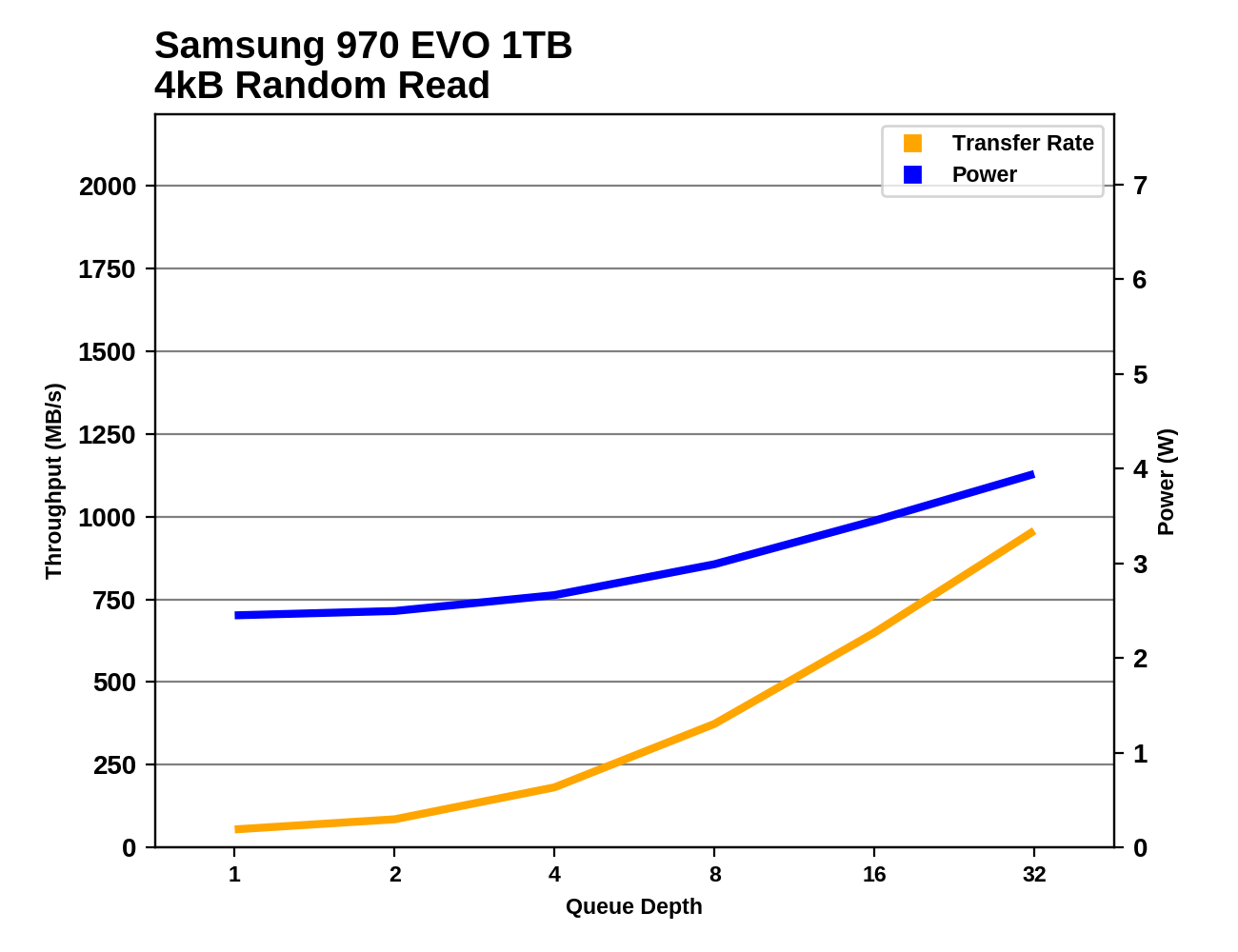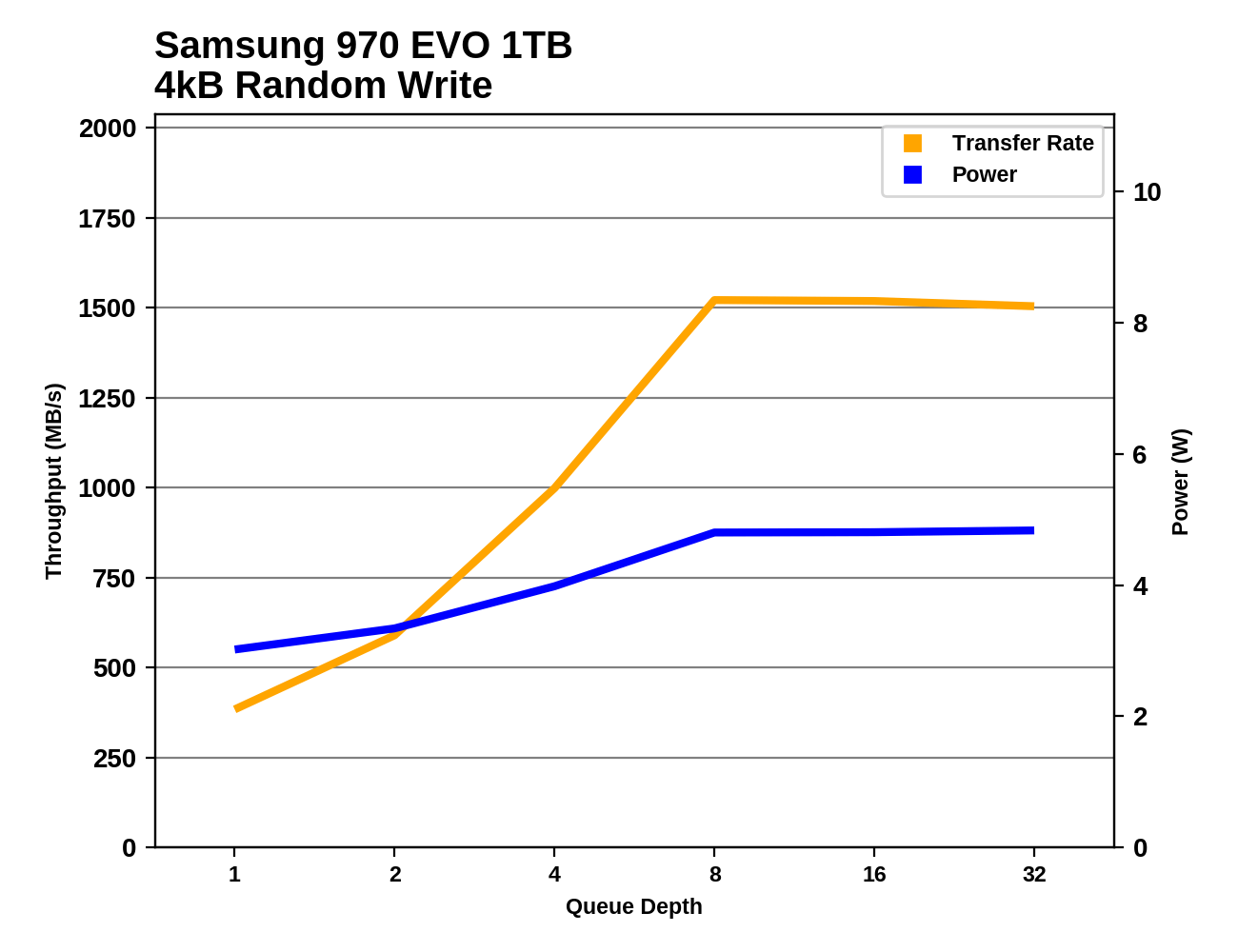The Mainstream Phoenix Rises: Samsung's 970 EVO (500GB & 1TB) SSDs Reviewed
by Billy Tallis on April 24, 2018 10:00 AM ESTRandom Read Performance
Our first test of random read performance uses very short bursts of operations issued one at a time with no queuing. The drives are given enough idle time between bursts to yield an overall duty cycle of 20%, so thermal throttling is impossible. Each burst consists of a total of 32MB of 4kB random reads, from a 16GB span of the disk. The total data read is 1GB.

The burst random read performance of the Samsung 970 EVO is the best they've ever delivered from TLC NAND flash memory, but the Intel SSD 760p is a few percent faster still.
Our sustained random read performance is similar to the random read test from our 2015 test suite: queue depths from 1 to 32 are tested, and the average performance and power efficiency across QD1, QD2 and QD4 are reported as the primary scores. Each queue depth is tested for one minute or 32GB of data transferred, whichever is shorter. After each queue depth is tested, the drive is given up to one minute to cool off so that the higher queue depths are unlikely to be affected by accumulated heat build-up. The individual read operations are again 4kB, and cover a 64GB span of the drive.

On the longer random read test, the Samsung 970 EVO proves to be the fastest TLC-based drive, but Samsung's MLC-based drives offer up to 20% higher performance.
 |
|||||||||
| Power Efficiency in MB/s/W | Average Power in W | ||||||||
The Samsung 970 EVO and its OEM sibling PM981 have the worst power efficiency of any recent high-end SSD during the random read test. The 970 EVO is drawing over 2.5W while Samsung's previous generation high end drives averaged less than 2W for very similar performance.
 |
|||||||||
The performance scaling of the 970 EVO is almost identical to that of the 960 EVO, but the 970 EVO draws more power throughout the random read test.
Random Write Performance
Our test of random write burst performance is structured similarly to the random read burst test, but each burst is only 4MB and the total test length is 128MB. The 4kB random write operations are distributed over a 16GB span of the drive, and the operations are issued one at a time with no queuing.

The burst random write performance from the Samsung 970 EVO is disappointing compared to the PM981, especially for the 1TB 970 EVO. Meanwhile, recent Intel and WD drives have been raising the bar with very fast SLC write caches.
As with the sustained random read test, our sustained 4kB random write test runs for up to one minute or 32GB per queue depth, covering a 64GB span of the drive and giving the drive up to 1 minute of idle time between queue depths to allow for write caches to be flushed and for the drive to cool down.

On the longer random write test, the 1TB PM981 provided top-tier performance, but the 1TB 970 EVO is about 12% slower, putting it on par with the previous generation from Samsung. The 500GB 970 EVO is also slightly slower than its PM981 counterpart.
 |
|||||||||
| Power Efficiency in MB/s/W | Average Power in W | ||||||||
Power efficiency has also regressed for the 970 EVO on the random write test, leaving it well below the standard set by the WD Black and the slower but similarly efficient Toshiba XG5.
 |
|||||||||
The random write performance of the 1TB 970 EVO tops out at just over 1.5 GB/s at queue depths of 8 and higher. The 500GB 970 EVO starts running out of SLC cache and showing inconsistent performance past QD4. The 1TB PM981 was able to ramp up performance much faster than the 970 EVO and hit a maximum of about 1.8GB/s before running out of SLC cache near the end of the test. The 512GB PM981 behaved very similarly to the 500GB 970 EVO.










68 Comments
View All Comments
jjj - Wednesday, April 25, 2018 - link
The conclusion was shocking, nowadays when nobody has ethics and they just try to sell and sell and sell. What you did there is like telling people that a 500$ GPU is nuts and really, I have zero expectations for anyone to say something like that anymore. Today is all about manipulating people into being stupid and buying a politician or a product.You should make your own site, would be the only honest hardware review site on the planet. People are getting worse and worse in managing their money and parents, schools, the press are not doing anything about it.
Congrats and thanks, I've missed seeing some sanity in a review.
peevee - Monday, April 30, 2018 - link
Yep. Now if only they would start including any real-life test. Recoding a large video. Compilation of a software package. Decompressing a zip archive. I suspect they don't do it because they need to sell ads from large-margin manufacturers like Samsung.hansmuff - Wednesday, May 2, 2018 - link
If only you'd read the article properly and see what the Destroyer etc tests actually ARE.. they're explained in great detail. Follow the links. All of those things ARE IN THERE.Urbanos - Sunday, May 6, 2018 - link
Its annoying that your charts seem to have little consistency, from chart to chart one can't easily follow the comparison part for part. Older Anandtech articles never had this problem.mapesdhs - Sunday, May 6, 2018 - link
Billy, I think it would worth adding something in the article somewhere to explain why in several cases the 950 Pro still shows so strongly after all this time. I'm intrigued. I knew it could beat the 960 EVO, but even so, sometimes it's above the 970 and other unexpected newer models.Ian.
Stephan0711 - Thursday, May 10, 2018 - link
960 pro 512 TB or 970 evo 500TB for desktop use / gaming? What do you guys think?Which benchmark represents this kind of usage?
ETHANH - Friday, May 11, 2018 - link
My friend just got a 970 pro 1TB yesterday, after we tried it out. I like my HP EX920 better, similar performance, much cheaper prices.Abad - Saturday, May 19, 2018 - link
Hi Friends,My pocket allows for the 512GB only and I was waiting results from the 970 and the EX920 before I write this: Toshiba RD400 512GB is the one to go for. If you factor in: price, performance and warranty, its unbeatable. To see 2016 MLC technology competing with Q2 2018 tech and winning must ring bells. Its no rocket science. The RD400 uses the more expensive and faster MLC cells, but because it comes from 2016, it is selling same price as the cheaper and slower TLC cells used in today's SSDs. You can't have a safer bet, can you?
But then, I heard some talk that OCZ SSDs go south but even that wont deter me from going for the RD400. What do you think?